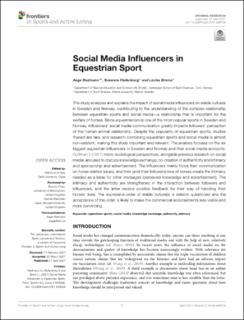| dc.contributor.author | Radmann, Aage | |
| dc.contributor.author | Hedenborg, Susanna | |
| dc.contributor.author | Broms, Lovisa | |
| dc.date.accessioned | 2022-03-21T21:29:29Z | |
| dc.date.available | 2022-03-21T21:29:29Z | |
| dc.date.created | 2021-11-01T11:16:54Z | |
| dc.date.issued | 2021 | |
| dc.identifier.citation | Frontiers in Sports and Active Living. 2021, 3, Artikkel 669026. | en_US |
| dc.identifier.issn | 2624-9367 | |
| dc.identifier.uri | https://hdl.handle.net/11250/2986641 | |
| dc.description | This is an open-access article distributed under the terms of the Creative Commons Attribution License (CC BY). The use, distribution or reproduction in other forums is permitted, provided the original author(s) and the copyright owner(s) are credited and that the original publication in this journal is cited, in accordance with accepted academic practice. No use, distribution or reproduction is permitted which does not comply with these terms. | en_US |
| dc.description.abstract | The study analyzes and explains the impact of social media influencers on stable cultures in Sweden and Norway, contributing to the understanding of the complex relationship between equestrian sports and social media—a relationship that is important for the welfare of horses. Since equestrianism is one of the most popular sports in Sweden and Norway, influencers' social media communication greatly impacts followers' perception of the human-animal relationship. Despite the popularity of equestrian sports, studies thereof are rare, and research combining equestrian sports and social media is almost non-existent, making this study important and relevant. The analysis focuses on the six biggest equestrian influencers in Sweden and Norway and their social media accounts. Goffman's (1967) micro-sociological perspectives, alongside previous research on social media, are used to discuss knowledge exchange, co-creation of authenticity and intimacy and sponsorship and advertisement. The influencers mainly focus their communication on horse-related issues, and their (and their followers) love of horses create the intimacy needed as a base for other messages (perceived knowledge and advertisement). The intimacy and authenticity are strengthened in the interaction between followers and influencers, and the latter receive positive feedback for their way of handling their horses' lives. The expressive order of stable culture(s) is seldom questioned and the acceptance of this order is likely to make the commercial endorsements less visible and more convincing. | en_US |
| dc.language.iso | eng | en_US |
| dc.subject | authencity | en_US |
| dc.subject | equestrian sports | en_US |
| dc.subject | intimacy | en_US |
| dc.subject | knowledge exchange | en_US |
| dc.subject | social media | en_US |
| dc.title | Social Media Influencers in Equestrian Sport | en_US |
| dc.type | Peer reviewed | en_US |
| dc.type | Journal article | en_US |
| dc.description.version | publishedVersion | en_US |
| dc.rights.holder | © 2021 Radmann, Hedenborg and Broms | en_US |
| dc.source.pagenumber | 13 | en_US |
| dc.source.volume | 3 | en_US |
| dc.source.journal | Frontiers in Sports and Active Living | en_US |
| dc.identifier.doi | 10.3389/fspor.2021.669026 | |
| dc.identifier.cristin | 1950121 | |
| dc.description.localcode | Institutt for lærerutdanning og friluftslivsstudier / Department of Teacher Education and Outdoor Studies | en_US |
| dc.source.articlenumber | 669026 | en_US |
| cristin.ispublished | true | |
| cristin.fulltext | original | |
| cristin.qualitycode | 1 | |
